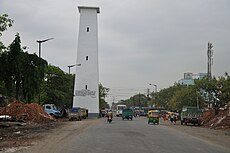Great Trigonometrical Survey

The Great Trigonometrical Survey of India was a project that aimed to carry out a
Among the many accomplishments of the Survey were the demarcation of the
The native surveyors made use of in the Himalayas, especially in

History
From its inception in 1600 to its domination of the entire

The Great Trigonometrical Survey of India started on 10 April 1802 with the measurement of a baseline near
The Trigonometrical Survey was conducted independently of other surveys, notably the topographical and revenue surveys. In 1875, the decision was taken that the Survey budget should be reduced from 240,000 to 200,000 pounds. This resulted in a reorganization under Surveyor-General Colonel J.T. Walker to amalgamate the Great Trigonometrical, Topographical and Revenue Surveys into the Survey of India.[9]

Instruments and methods used
Triangulation surveys were based on a few carefully measured baselines and a series of angles. The initial baseline was measured with great care since the accuracy of the subsequent survey was critically dependent upon it. Various corrections were applied, principally temperature. An especially accurate

Accurate instruments could not always be purchased through the standard system of government contract, and Everest personally supervised the construction of instruments. He had a maker, Henry Barrow, set up an instrument company in Calcutta. Barrow was succeeded by Syed Mohsin from Arcot, Tamil Nadu, and after his death, the instruments were supplied by Cooke from York.[11][12]
Correcting deviations
To achieve the highest accuracy, a number of corrections were applied to all distances calculated from simple trigonometry:
- Curvature of the Earth
- The non-spherical nature of the curvature of the Earth
- Refraction
- Height above mean sea level
Superintendents
- 1818–1823 – William Lambton
- 1823–1843 – Sir George Everest
- 1843–1861 – Andrew Scott Waugh
- 1861–1883 – James Thomas Walker
- 1884–1888 – Charles Thomas Haig
- 1888–1894 – George Strahan
- 1894–1899 – St George Corbet Gore
- 1899–1911 – Sidney Gerald Burrard
- 1912–1921 – Sir Gerald Ponsonby Lenox-Conyngham
See also
Notes
References
- ^ a b c d e Gill, B. (2001); "THE BIG MAN. Surveying Sir George Everest", in: Professional Surveyor Magazine, Vol. 21 Nr 2. Retrieved online Archived 10 February 2017 at the Wayback Machine 8 March 2016.
- Oxford UniversityPress.
- ^ Derek J. Waller, 2004, "The Pundits: British Exploration of Tibet and Central Asia," University Press of Kentucky.
- ^ Account of the Pundit's Journey in Great Tibet - Capt. H. Trotter, The Journal of the Royal Geographical Society (1877).
- ^ Lambton, William (1811). "An account of the Trigonometrical Operations in crossing the peninsula of India, and connecting Fort St. George with Mangalore". Asiatic Researches; or Transactions of the Society Instituted in Bengal for Inquiring into the History and Antiquities: 290–384.
- ^ "bone, v.3". Oxford English Dictionary (Online ed.). Oxford University Press. (Subscription or participating institution membership required.)
- ^ Markham, Clements (1878). A Memoir on the Indian Surveys (2 ed.). London. W H Allen And Co. p. 67. Retrieved 1 March 2009.
- ^ Bluesci: Cambridge university science magazine, 29 January 2011,"History: The Great Trigonometrical Survey" "BlueSci » History: The Great Trigonometrical Survey". Archived from the original on 27 July 2014. Retrieved 5 May 2013.
{{cite web}}: CS1 maint: bot: original URL status unknown (link), Cambridge. - ^ Black, Charles E.D. (1891). A memoir of the Indian Surveys, 1875–1890. London: Secretary of State for India in Council. pp. 39–40.
- ^ R., Ramachandran (2 June 2021) [Originally appeared in print version on April 27, 2002]. "Survey Saga". frontline.thehindu.com. Retrieved 26 December 2022.
- ^ Strahan, C. (1903). "The Survey of India". Professional Papers of the Corps of Royal Engineers. 28: 141–171.
- ^ Insley, Jane (1995). "Making mountains out of molehills? George Everest and Henry Barry, 1830–39" (PDF). Indian Journal of History of Science. 30 (1): 47–55. Archived from the original (PDF) on 25 January 2014.
- JSTOR 108510.
Further reading
- Edney, Matthew H. (2009). Mapping an Empire: The Geographical Construction of British India, 1765-1843. University of Chicago Press. ISBN 978-0-226-18486-9.
- ISBN 0-00-257062-9.
- Dean, Riaz (2019). Mapping The Great Game: Explorers, Spies & Maps in Nineteenth-century Asia. Oxford: Casemate (UK). pp. 67–123. ISBN 978-1-61200-814-1.
- Deb Roy, Rama (1986), "The Great Trigonometrical Survey of India in a Historical Perspective" (PDF), Indian Journal of History of Science, 21 (1): 22–32, archived from the original (PDF) on 25 January 2014
- Reginald Henry Phillimore, Historical Records of the Survey of India, 5 vols. Dehra Dun, Survey of India (1945–1968)
